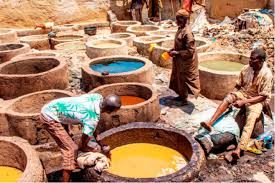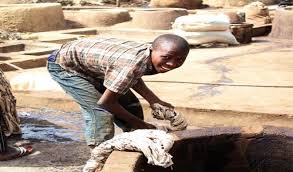If Kano is the heartbeat of Northern Nigeria’s history, then Kofar Wambai Tannery is one of its living arteries, pulsing with tradition, color, and craft. Step into this centuries-old site, and you won’t just be visiting a tannery, you’ll be entering a world where every hide, every pit, and every artisan’s hand carries a story.

A Walk Through Time
The tannery’s origins stretch back over a hundred years, when it first operated near the Emir’s palace before moving to its current site beside the bustling Kofar Wambai Market. In its heyday, hides from here traveled across the Sahara, carried on camel backs, and traded as prized goods in North Africa and the Middle East. Today, the tannery remains a vivid reminder of Kano’s reputation as one of Africa’s oldest leather capitals.
Read Also: Your Guide to Higher Education in Kano: Discover Top Universities in the State
Sights, Sounds, and Scents
Visiting Kofar Wambai Tannery is an experience for all the senses.
- Sight: Rows of open-air pits filled with earthy browns, deep blacks, and vibrant reds where hides soak and transform.
- Sound: The rhythmic scraping of artisans at work, mixed with the lively chatter of apprentices learning the trade.
- Scent: The unmistakable earthy aroma of hides, ashes, and natural dyes, raw and authentic.
It’s not polished, it’s not sanitized, it’s real. And that’s exactly what makes it unforgettable.

The Craft of Leather
Here, tanning is more than work, it’s heritage. Skilled men dip raw hides into a mixture of potash and ash, scrape them smooth, and dye them in traditional colors. Under the sun, the leather is stretched and dried, eventually shaped into sandals, belts, mats, and bags. Each piece bears the marks of craftsmanship passed down through families for generations.
Some say the world’s most luxurious “Moroccan leather” has its roots in Kano, processed here, but exported under different names. That alone makes Kofar Wambai a hidden gem of global significance.
Meeting the Artisans
What makes the visit extraordinary is the people. You’ll meet master tanners whose hands are darkened from decades of work, proud to show how their fathers and grandfathers once stood in the same pits. Young apprentices, eager to learn, beam with excitement when visitors ask questions. Their stories breathe life into the leather.
Why Go Now
The tannery is at a crossroads. Modern tanneries, cheaper imports, and lack of support have put pressure on this traditional craft. Yet, artisans remain resilient, determined to keep their heritage alive. By visiting, photographing, or even buying a piece of handmade leather, you’re helping preserve a piece of Kano’s history.
Practical Tips for Visitors
- When to Visit: Early morning is best, work is in full swing, and the soft light makes for stunning photos.
- What to Wear: Dress modestly to respect local culture; light clothes are recommended for the heat.
- Photography: Always ask before snapping photos, most artisans are welcoming when approached politely.
- Getting There: The tannery is within Kano city, near Kofar Wambai Market. A local guide can make your visit easier and more enriching.
Kofar Wambai Tannery is not just a place to see leather, it’s a place to feel history. It’s where tradition meets resilience, where every hide tells the story of survival, and where you, as a traveler, can step into a narrative woven over centuries.
So next time you’re in Kano, don’t just shop in the market, wander into the tannery. Let the colors, the craft, and the people remind you that culture isn’t always kept in museums; sometimes, it’s alive in the hands of those who still practice it.

